Rooks are over-rated!
Rooks are five points, minor pieces are three. Everyone is taught this when they begin their journey in chess. The road to chess mastery involves in understanding when this material evaluation is not true! Great players like Nimzowitch, Botvinnik, Gligoric, Petrosian knew the value of the exchange sacrifice so well that they used it as a powerful tool to finish off their opponents. In order that you too can understand the nuances of this positional concept, Sergei Tiviakov is here with his latest DVD. ChessBase India reviewer Davide Nastasio presents to you his findings.
The Art of the Positional Exchange Sacrifice - Sergey Tiviakov

Tiviakov begins mentioning his last DVD: "Learning from the World Champions," which was well received by the chess community, giving him the idea of creating a series of DVDs on chess strategy.
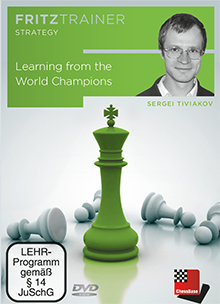
The topic of this (Exchange sacrifice) DVD: the sacrifice of material for a better position, is a difficult transition point in the life of every player. But it is also quite rewarding, since the games can become exciting. The positional exchange sacrifice can become a powerful tool in a player's hands if used correctly.
Before showing a brilliant game with such a sacrifice, I'd like to show a position from it, and ask you to guess the next move.

This game well illustrates into action the concept of positional sacrifice.
[Site "Linares ESP"]
[Date "1994.02.??"]
[Round "4"]
[White "Anatoly Karpov"]
[Black "Veselin Topalov"]
[Result "1-0"]
[ECO "A33"]
[PlyCount "77"]
[EventDate "1994.??.??"]
Nc3 O-O 9. O-O d6 10. Bf4 Nh5 11. e3 Nxf4 12. exf4 Bd7 13. Qd2 Qb8 14. Rfe1 g6
15. h4 a6 16. h5 b5 17. hxg6 hxg6 18. Nc5 dxc5 19. Qxd7 Rc8 20. Rxe6 Ra7 21.
Rxg6+ fxg6 22. Qe6+ Kg7 23. Bxc6 Rd8 24. cxb5 Bf6 25. Ne4 Bd4 26. bxa6 Qb6 27.
Rd1 Qxa6 28. Rxd4 Rxd4 29. Qf6+ Kg8 30. Qxg6+ Kf8 31. Qe8+ Kg7 32. Qe5+ Kg8 33.
Nf6+ Kf7 34. Be8+ Kf8 35. Qxc5+ Qd6 36. Qxa7 Qxf6 37. Bh5 Rd2 38. b3 Rb2 39.
Kg2 1-0
In the DVD Tiviakov shows when such sacrifice is required, what are the principles governing the sacrifice, and how to realize it in our own games!
Sometimes the real problem for the amateur is that the sacrifice is not seen, because one cannot see the benefits right away, and that makes it difficult to imagine it.
Another aspect is also psychology. Many don't realize it, but chess, for humans, is heavily influenced by individual psychology. Like Tiviakov points out there is a definite relationship between our own inner greediness and the way we play chess. Even for World Champions to reject the material offer is difficult.
Tiviakov begins the DVD showing a great example by Nimzowitsch.

While showing different examples of positional sacrifices, he also explains important elements of the game, like the blockade:

Tiviakov while commenting on a game introduces and explains many middlegame elements we must all know and learn. Practically after watching the DVD one will understand better the middlegame and will be able to see in master's games motifs like: centralization, prophylaxis, fight for the center, and many other elements discussed by Tiviakov when explaining the games he shows.
Returning to the position above, as you can see from such example, the Bc8 is also blocked, and cannot develop on d7, at the same time the rook on a8 cannot come out because of the bishop.
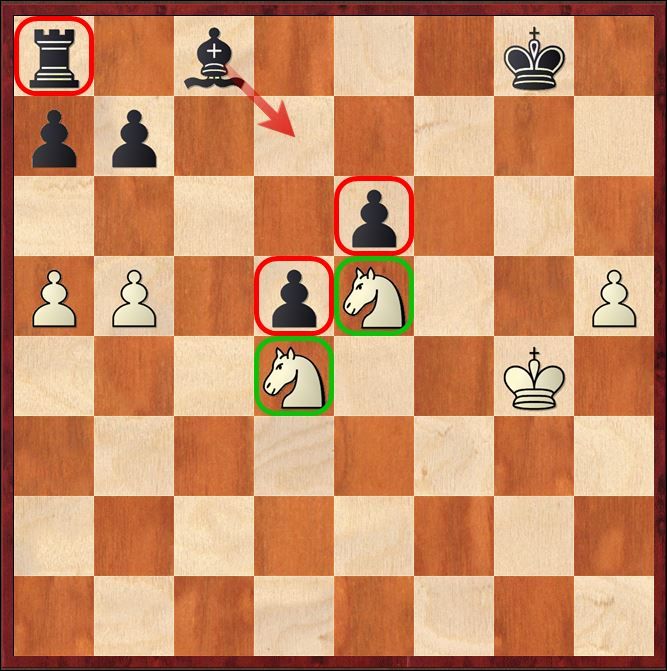
From such a position we can already devise a principle related to blockaded positions, or the control of important squares. Such principle would guide us to avoid exchanging pieces, because we sacrificed material, and consequently we need to keep the position closed to keep the activity of the enemy pieces low.
Throughout the DVD Tiviakov reveals important info for the growing player, for example he explains how the former World Champion Tigran Petrosian was a master of the positional sacrifice.
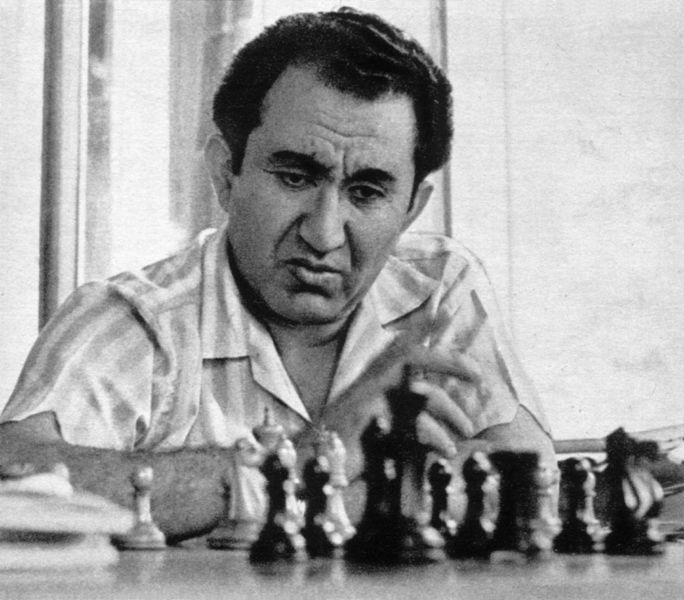
This means that we need to look at his games and discover which one has such a sacrifice. Obviously when a teacher of the caliber of Tiviakov tells me: "Petrosian is the master of a certain technique... or positional principle," I begin to go over Petrosian's games, to find what Tiviakov was speaking about, and here I'd like to share one of the games I found:

[Site "m"]
[Date "1966.04.25"]
[Round "7"]
[White "Boris Spassky"]
[Black "Tigran Vartanovich Petrosian"]
[Result "0-1"]
[ECO "D03"]
[PlyCount "86"]
[EventDate "1966.??.??"]
Bb7 9. Ne5 Nxe5 10. dxe5 Nd7 11. Bf4 Qc7 12. Nf3 h6 13. b4 g5 14. Bg3 h5 15. h4
gxh4 16. Bf4 O-O-O 17. a4 c4 18. Be2 a6 19. Kh1 Rdg8 20. Rg1 Rg4 21. Qd2 Rhg8
22. a5 b5 23. Rad1 Bf8 24. Nh2 Nxe5 25. Nxg4 hxg4 26. e4 Bd6 27. Qe3 Nd7 28.
Bxd6 Qxd6 29. Rd4 e5 30. Rd2 f5 31. exd5 f4 32. Qe4 Nf6 33. Qf5+ Kb8 34. f3 Bc8
35. Qb1 g3 36. Re1 h3 37. Bf1 Rh8 38. gxh3 Bxh3 39. Kg1 Bxf1 40. Kxf1 e4 41.
Qd1 Ng4 42. fxg4 f3 43. Rg2 fxg2+ 0-1
Tiviakov did a great job in selecting games from Petrosian which taught how the blockade can give rise to the positional sacrifice. However I disagree on a statement he made on video no.3, about 30 seconds into the video, saying: "likely Gligoric, (a real chess giant in my opinion), learned the positional exchange sacrifice thanks to Petrosian."
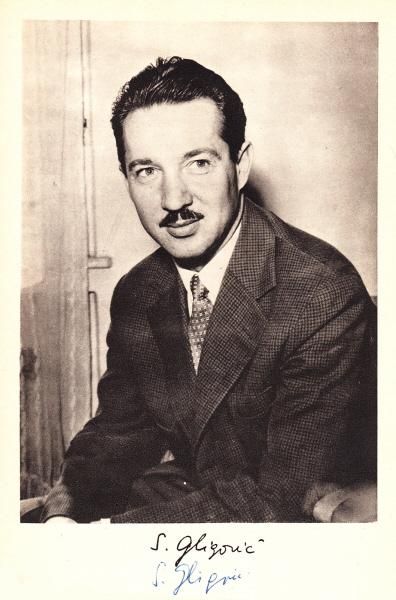
This game was played in the chess Olympiad in 1962, and in it we can see how Petrosian saves the day thanks to a positional exchange sacrifice on move 28, leaving en prise the rook on e1, and then blocking the position with Ne4.
[Site "Varna BUL"]
[Date "1962.09.28"]
[Round "2"]
[White "Tigran Vartanovich Petrosian"]
[Black "Svetozar Gligoric"]
[Result "1/2-1/2"]
[ECO "E94"]
[PlyCount "61"]
[EventDate "1962.??.??"]
Nc5 9. Qc2 a5 10. Bg5 h6 11. Be3 Nfd7 12. Nd2 f5 13. exf5 gxf5 14. f4 exf4 15.
Bxf4 Ne5 16. Nf3 Ng6 17. Be3 Qe7 18. Qd2 f4 19. Bf2 Ne5 20. Nxe5 Bxe5 21. Bd4
Bf5 22. Rf2 Bg6 23. Raf1 Qg5 24. Bxe5 dxe5 25. Kh1 Ra6 26. Bf3 Raf6 27. Re1 Nd3
28. Rfe2 Nxe1 29. Qxe1 Re8 30. c5 Rff8 31. Ne4 1/2-1/2
Obviously the book Zurich 1953, really taught all possible positional strategic and tactic elements to everyone who really studied it.

And in such book we saw the famous game Reshevsky vs Petrosian with a beautiful positional sacrifice. This could lead someone to think that Gligoric learned the position exchange sacrifice studying this book.
However, many people just focus on major players like Fischer, Kasparov or Karpov, but Gligoric was really someone to learn from. Watch this game, and the stunning positional sacrifice played in 1951, quite before Zurich 1953, and Varna 1962!
[Site "Birmingham"]
[Date "1951.??.??"]
[Round "7"]
[White "Ernst Ludwig Klein"]
[Black "Svetozar Gligoric"]
[Result "0-1"]
[ECO "E72"]
[PlyCount "94"]
[EventDate "1951.??.??"]
Nbd7 9. O-O Re8 10. f3 c6 11. Nc2 Nb6 12. Ne3 Be6 13. Qd3 Qc7 14. f4 Rad8 15.
Bd2 d5 16. cxd5 cxd5 17. Nb5 dxe4 18. Nxc7 Rxd3 19. Nxe8 Nxe8 20. Bc1 Bd4 21.
Re1 Nc4 22. Bxe4 Rxe3 23. Bxe3 Nxe3 24. Kh1 Nd6 25. Bg2 Nxg2 26. Kxg2 Bd5+ 27.
Kf1 Bxb2 28. Rad1 Bc4+ 29. Kg2 Nf5 30. g4 Nd4 31. Kg3 b5 32. Re8+ Kg7 33. Ra8
Ne2+ 34. Kf3 Nc3 35. Rdd8 Be2+ 36. Kg3 Ne4+ 37. Kh3 Bf1+ 38. Kh4 Bf6+ 39. g5
Bxd8 40. Rxd8 a5 41. Ra8 a4 42. a3 Bc4 43. Re8 Nd6 44. Re1 Nf5+ 45. Kg4 Nd4 46.
Rc1 Be6+ 47. Kh4 Bb3 0-1
And for those who still have doubts, here another game played by Gligoric in 1952, which also shows the positional sacrifice (centralization of the knight, which support the attack on the kingside, for the Rf1 which is not really helping to finish off the enemy! Notice also how the knight on d4 closes the d-file):
[Site "Belgrade"]
[Date "1952.??.??"]
[Round "13"]
[White "Svetozar Gligoric"]
[Black "Zvonko Krzisnik"]
[Result "1-0"]
[ECO "D46"]
[PlyCount "81"]
[EventDate "1952.??.??"]
b6 9. Bb2 Bb7 10. Qe2 Rc8 11. Rfd1 Qc7 12. Rac1 Qb8 13. Ne5 Nxe5 14. dxe5 Nd7
15. f4 Rfd8 16. Rf1 dxc4 17. Bxc4 b5 18. Bd3 Nc5 19. Bb1 b4 20. Qc2 g6 21. Ne2
Ba6 22. Nd4 Bxf1 23. Rxf1 Qb6 24. f5 exf5 25. Nxf5 Bf8 26. Bd4 Qb5 27. Qf2 Rd7
28. Nd6 Bxd6 29. exd6 Ne6 30. Bb2 Qg5 31. Bd3 Rf8 32. h4 Qh6 33. Be5 Re8 34.
Bc4 Nd8 35. Bd4 Re4 36. Qf6 Rxd4 37. Qxd4 Qf8 38. Rf6 Nb7 39. Qxa7 c5 40. Rxf7
Rxf7 41. Qxb7 1-0
Unfortunately I must admit I also didn't study enough Gligoric, but, it is possible that his inspiration to learn the positional sacrifice was Botvinnik, whose games surely were famous in the Soviet Union, and areas heavily influenced by Russia, like the Yugoslavia in which Gligoric was living.
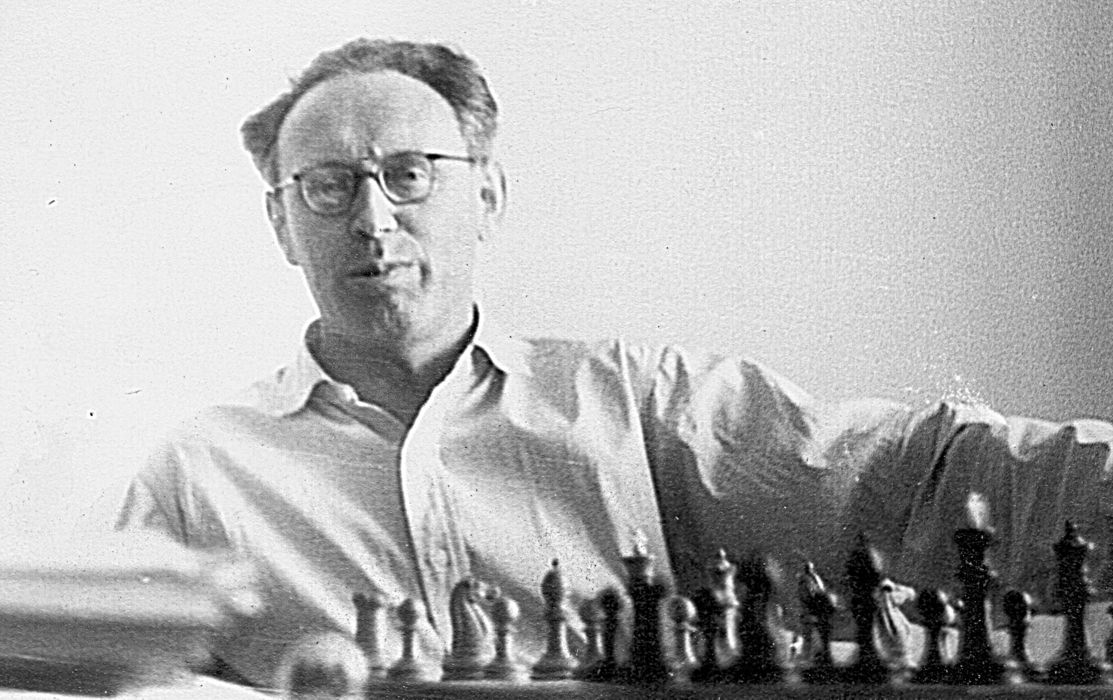
The following game by Botvinnik shows also positional exchange sacrifice, and clearly shows that each player to reach the Master level needs to be able to play positional exchange sacrifices in his games.
[Site "Leningrad tt"]
[Date "1931.??.??"]
[Round "?"]
[White "A Yurgis"]
[Black "Mikhail Botvinnik"]
[Result "0-1"]
[ECO "A15"]
[PlyCount "74"]
[EventDate "1931.??.??"]
Be7 9. Bb2 O-O 10. Nxd5 Bxd5 11. d3 Nd7 12. Qc2 Rc8 13. Rae1 b5 14. e4 Bb7 15.
Nd2 Nb8 16. f4 Nc6 17. a3 Qd7 18. Nf3 Rfd8 19. Rd1 Ba6 20. Ba1 b4 21. a4 Nd4
22. Qb2 Bf6 23. e5 Be7 24. Nxd4 cxd4 25. Qe2 Rc5 26. Bb2 f5 27. h4 Rc3 28. Bxc3
dxc3 29. Qe3 Bxd3 30. Rf2 Qd4 31. Qxd4 Rxd4 32. Bf1 c2 33. Rc1 Bxf1 34. Rcxf1
Rc4 35. bxc4 Bc5 36. Kg2 Bxf2 37. Kxf2 b3 0-1
This last game, and others played by Botvinnik in the 1930s and 1940s, could have been what taught Gligoric such an important chess idea. In fact one of the main concepts of another good DVD made by ChessBase: "Learn from the Classics," is based upon the importance of studying the games of the masters of the past, in order to learn middlegame ideas and patterns we will use in our games, and Gligoric is a clear example of how to learn from Botvinnik!

After this long parenthesis upon who taught the positional exchange sacrifice to Gligoric, let's return to finish the review of this DVD!
The DVD is made by 26 videos, 24 if we count off the introduction, and conclusion, in which different games are used as example, some coming from Tiviakov's practice too!
Then there are 10 test positions, which use the interactive FritzTrainer system, practically Tiviakov shows a game or a position, and ask us to find the correct moves in order to win. Then when we give the wrong answer, we often receive a video clip with the feedback of why that move wasn't good.
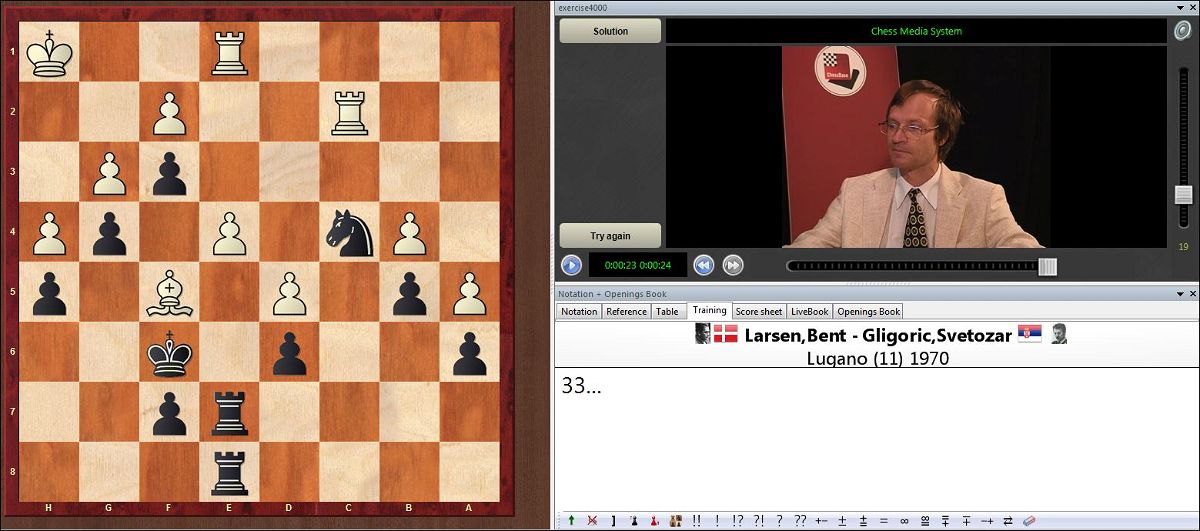
[Site "Lugano"]
[Date "1970.??.??"]
[Round "11"]
[White "Larsen, Bent"]
[Black "Gligoric, Svetozar"]
[Result "0-1"]
[ECO "E97"]
[SetUp "1"]
[FEN "4r3/4rp2/p2p1k2/Pp1P1B1p/1Pn1P1pP/5pP1/2R2P2/4R2K b - - 0 33"]
[PlyCount "25"]
[EventDate "1970.??.??"]
[EventType "tourn"]
[EventRounds "14"]
[EventCountry "SUI"]
[SourceTitle "MCD"]
[Source "ChessBase"]
[SourceDate "1999.07.01"]
[SourceVersion "1"]
[SourceVersionDate "1999.07.01"]
[SourceQuality "1"]
39. Rd3 fxg3 40. fxg3 Ne3+ 41. Kf2 Nxd5 42. Re1 Rxe1 43. Kxe1 Nf6 44. Rc3 Ne4
45. Rc6 Kd4 0-1
The DVD comes with a database of the games used in the videos, they are 35. Then another database of games based on the exercises, which are 10. And finally a database of extra games: 50 in total. For Petrosian lovers, Tiviakov has put at least 20 of Petrosian's games in the Extra Games database, which shows the big influence Petrosian had over Tiviakov, and the good influence it could have upon us, if we study those games.
In conclusion: someone can think books are better, but it is not true. Here we have a passionate teacher, giving us all the wisdom he can, and giving us also material for training, and studying. I don't think one can have a better deal if he wants to learn this part of the middlegame, and apply it in his own games.
About the Author

Davide Nastasio is a novel chess aficionado, who has made of chess his spiritual tool of improvement, and self-discovery. One of his favorite quotes is from the great Paul Keres: "Nobody is born a master. The way to mastery leads to the desired goal only after long years of learning, of struggle, of rejoicing, and of disappointment..." He is one of the main writers for ChessCafe on Chessbase products, he authors articles on British Chess Magazine, and he is one of the main contributors of Georgia Chess Magazine in the new electronic format: Georgia Chess News. He is an active player, and organizes and directs chess tournaments.
More reviews by Davide:
Mining the pastures of ChessBase 14
Black Lion - an agressive version of the Philidor
